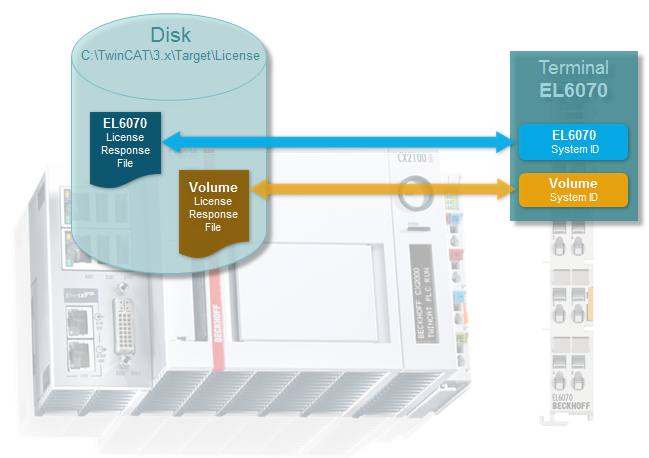Basic function principles
Basic function principles
The TwinCAT dongle device (here: EL6070) is a special piece of hardware that can be read by TwinCAT 3.
On the IPC the so-called License Response File contains the licenses that are valid for this system. If the License Response File also contains a check against a dongle, TwinCAT looks for the dongle and checks
- whether it is a Beckhoff device
- whether it is a specific Beckhoff device
After successful checking the licenses are available according to the LicenseResponseFile.
The EL6070 has no other user functions.
From hardware version 02 the EL6070 also features a local memory, so that one or several LicenseResponseFiles can be stored and transported on the dongle.
From FW05/Rev0019, the EL6070 has a non-erasable operating hours counter in CoE xF900:01 in the unit [sec] which counts when the Ebus voltage is applied.
 Fig.22: Object F900:01, operating hours counter
Fig.22: Object F900:01, operating hours counter Fig.23: TwinCAT dongle architecture
Fig.23: TwinCAT dongle architecture Since the dongle technology is primarily a TwinCAT functionality, further information about the application can be found in the TwinCAT documentation at http://infosys.beckhoff.com/.
Please note that, as an EtherCAT master, TwinCAT checks the complete terminal name during startup, i.e. EL6070-0000 or EL6070-1234 (as an example). A corresponding ESI must therefore exist in the TwinCAT system.
 | Firmware Update The firmware on the EL6070 cannot be updated. The EtherCAT revision can be updated, if necessary. |
 | Vulnerability of security hardware The hardware used in the dongle ensures that, according to present knowledge, any attacks on the hardware-related checks would require very substantial financial and time effort.No cryptographic system can be made categorically secure against any conceivable attackers (e.g. state-sponsored attackers). Whether and how successful an attack against an encryption technology can be carried out always boils down to "just" a question of financial resources (processing power, laboratory equipment, staff, availability) and time resources. Another factor is human behavior, which is associated with the organizational procedures of the system and cannot be made secure through hardware and software (“social engineering”).Technological progress may open up future attack options that are unknown today and may require a reassessment of the cryptographic system.The cryptography chosen for the Beckhoff dongle is based on the present state of the art. |